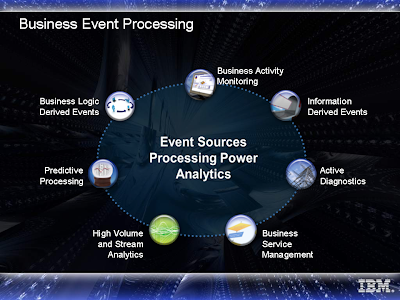
The illustration above talks about classification in the animal universe; classifications is one of the best way to understand the universe. In our context, I have started in the previous posting to discuss types of functions that exist in Event Processing generic tools. Today I'll complete the picture by discussing classes of applications. This classification is not a partition, a certain application can have elements of multiple classes. This classification answers the question ---
what benefit the customer expect to obtain from an event processing system ?
The illustration below is an IBM classification of what is "Business Event Processing", this is a slightly modified version of results of study we conducted within an IBM Academy of Technology study that analyzed some use cases. The use cases working group of EPTS is now repeating this exercise, three years later, and with probably somewhat broader perspective, so the end result may be different, but this will provide a sense of this type of classification:
 Starting from the top and going anti-clockwise (I am left-handed...)
Starting from the top and going anti-clockwise (I am left-handed...)- Business Activity Monitoring (BAM): Observation on collection of activities to find exceptions and monitor key performance indicators to alert business stakeholders. This typically requires aggregations and predefined pattern matching.
- Business logic derived events (sometimes called RTE - Real-Time Enterprise): detecting situations that require reaction (typically with some time constraints). The derivation of the situation may be either by predefined patterns (e.g. regulation enforcement) or by discovered patterns (fraud detection). Most of the applications use predefined patterns.
- Predictive Processing: Processing future predicted event in order to eliminate or mitigate them.
- Stream Analytics: Analysis of various streams (video, voice, data etc..) to derive individual events (e.g. from video stream) or trends - this includes "real-time business intelligence".
- Business Service Management: Monitoring satisfaction of Service Level Agreement (SLA) of IT systems.
- Active Diagnostics: Finding the root-cause problem by looking at collection of symptoms.
- Information Derived Events (also know as "information dissemination") -- personalized subscription that provide the right information at the right granularity to the right person at the right timing.
No comments:
Post a Comment